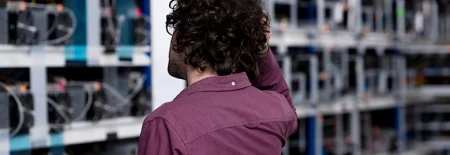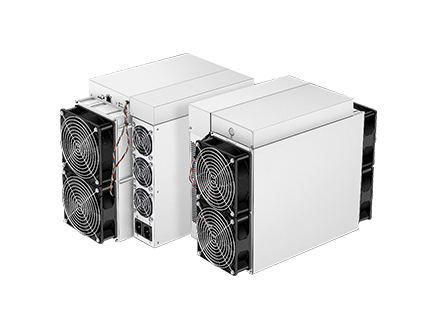I. Introduction
In the ever-evolving world of cryptocurrency, Bitcoin has consistently remained a beacon of intrigue and opportunity. Recently, a significant development has caught the attention of investors and enthusiasts alike: the soaring fees associated with Bitcoin transactions. These escalating costs, while presenting a challenge for some, signal a unique and timely opportunity for others. Specifically, this surge in fees has opened a new window for investing in Bitcoin mining machines – a venture that was once viewed with skepticism due to fluctuating market conditions.
In this comprehensive guide, we’ll delve into the intricacies of Bitcoin fees, their impact on the network, and why, in light of these rising costs, now is an opportune moment to invest in Bitcoin mining machines. We aim to provide a thorough understanding of the current landscape and equip you with the knowledge to make informed decisions in this dynamic domain.
II. Understanding Bitcoin Fees
Bitcoin fees are an essential component of the cryptocurrency’s ecosystem, serving as both an incentive for miners and a mechanism for managing the network’s limited capacity. These fees are paid to miners for validating and adding transactions to the blockchain, the decentralized ledger that underpins Bitcoin.

To understand Bitcoin fees, it’s crucial to grasp the concept of blockchain mining. Miners use powerful computers to solve complex mathematical problems, which validate and secure transactions. In return for their efforts, they are rewarded with newly minted bitcoins and transaction fees. The fee is essentially a bid; users propose a fee to have their transaction included in the next block, and miners prioritize transactions with higher fees.
Historically, Bitcoin fees have fluctuated significantly. In the early days of Bitcoin, fees were relatively low due to minimal network congestion and the novelty of the cryptocurrency. However, as Bitcoin gained popularity, the demand for transaction space on the blockchain increased, leading to higher fees. This trend is particularly evident during market surges when transaction volumes spike, and the network experiences increased congestion.
The recent surge in Bitcoin fees can be attributed to several factors. One of the primary reasons is the growing interest in Bitcoin as an investment and a hedge against traditional financial systems. This surge in interest has led to increased transaction volumes, pushing the fees higher. Additionally, events such as the halving of Bitcoin rewards (which occurs approximately every four years) also contribute to fee increases, as they reduce the supply of new bitcoins entering the market, making transaction fees a more significant part of miners’ rewards.

III. The Impact of High Fees on the Bitcoin Network
The surge in Bitcoin fees has a multifaceted impact on the network, affecting everything from user experience to the overall health and security of the system. Understanding these impacts is crucial for anyone involved in the Bitcoin ecosystem.
- User Experience:For regular users of Bitcoin, high transaction fees can be a significant deterrent. This is especially true for small transactions, where the fee might outweigh the value of the transaction itself. High fees can lead to a decrease in the use of Bitcoin for everyday purchases and may push users towards other cryptocurrencies with lower transaction costs.
- Network Congestion and Transaction Speed:High fees are often a symptom of network congestion. As more transactions vie for a spot in the limited block space, users are forced to increase their fees to prioritize their transactions. This congestion can lead to slower transaction times during peak periods, as lower-fee transactions are left waiting for inclusion in a block.
- Security and Decentralization:Interestingly, high fees can have a positive impact on the network’s security. They provide a greater incentive for miners to continue their work, which is crucial for maintaining the blockchain’s integrity. However, there’s a delicate balance to be struck. Excessively high fees could centralize mining power in the hands of a few large players who can afford to sustain operations, potentially compromising the decentralized nature of Bitcoin.
- Comparison with Traditional Banking Fees:When compared to traditional banking fees, Bitcoin’s high transaction fees can be seen in a different light. While certain Bitcoin transactions may be more expensive than traditional ones, Bitcoin offers distinct advantages such as decentralization, increased privacy, and freedom from banking regulations and holidays. For international transactions, especially, Bitcoin can sometimes offer a more efficient and less costly alternative to traditional banking systems.
- Encouraging Layer 2 Solutions:High fees on the Bitcoin network have spurred interest and development in secondary layer solutions, like the Lightning Network. These solutions aim to reduce the burden on the main blockchain by handling transactions off-chain, thus providing faster transactions with lower fees, while still maintaining the security benefits of the Bitcoin network.
IV. Bitcoin Mining Basics
Bitcoin mining is a fundamental process that underpins the functionality and security of the Bitcoin network. It involves the validation and recording of transactions on the Bitcoin blockchain. Here’s a basic overview of how it works and its relationship with transaction fees:
- The Process of Mining: Mining involves solving complex cryptographic puzzles to validate transactions and add them to the blockchain. Miners use specialized hardware to compete in solving these puzzles. The first miner to solve the puzzle gets the right to add a new block of transactions to the blockchain and is rewarded with newly minted bitcoins (block reward) and transaction fees from the transactions included in the block.
- Mining Hardware: Early in Bitcoin’s history, mining could be done using regular computers. However, as the difficulty of the puzzles increased, more specialized and powerful hardware was required. This led to the development of ASICs (Application-Specific Integrated Circuits), which are specifically designed for Bitcoin mining. These machines offer significant computational power, making them much more efficient than general-purpose hardware for mining.
- Mining and Transaction Fees: Miners prioritize transactions with higher fees when selecting them for inclusion in a new block. This means that users who pay higher fees are more likely to have their transactions processed quickly. As a result, transaction fees become an important part of a miner’s revenue, especially as the block reward continues to halve approximately every four years.
- Software Requirements: In addition to hardware, miners also need the right software to connect to the Bitcoin network. This software delivers the work to the miners, collects the completed work, and adds the newly validated block to the blockchain. It also helps miners stay in sync with the network and provides them with data on the current state of the network.
- Mining Pools: Due to the competitive nature of mining and the increasing difficulty of puzzles, individual miners often find it hard to compete with larger setups. This has led to the creation of mining pools, where miners combine their computational power and share the rewards based on the contributed processing power.
- Energy Consumption: Bitcoin mining is known for its high energy consumption, which has raised environmental concerns. The energy-intensive process is necessary to maintain the network’s security but has led to debates about sustainable practices in mining.

V. Why Invest in Bitcoin Mining Machines Now?
In the current landscape of soaring Bitcoin fees, investing in Bitcoin mining machines presents a compelling opportunity. Here’s why this is an opportune time to consider such an investment:
- Increased Revenue from Fees:With the rise in Bitcoin transaction fees, miners stand to gain more from their mining activities. The fees paid for each transaction included in a new block can significantly boost a miner’s earnings, especially when combined with the block reward. This increase in potential revenue makes mining a more lucrative venture than it was during periods of lower fees.
- Halving of Block Rewards:Bitcoin undergoes a halving event approximately every four years, where the reward for mining a new block is cut in half. This reduction in block rewards makes transaction fees a more substantial part of a miner’s income. As the next halving event approaches, the importance of transaction fees will only grow, making now an ideal time to invest in mining hardware.
- Long-Term Investment Potential:Despite the volatility of Bitcoin prices, the long-term trend has shown substantial growth. Investing in mining hardware can be a way to accumulate Bitcoin without purchasing it directly at potentially high prices. As the value of Bitcoin is anticipated to rise over the long term, the bitcoins earned through mining could appreciate in value.
- Technological Advancements in Mining Hardware:The continuous advancement in mining technology has led to more efficient and powerful mining machines. These newer models offer better hash rates and energy efficiency, reducing operational costs and increasing profitability. Investing in the latest mining hardware can provide a competitive edge.
- Diversification of Investment Portfolio:For those already investing in cryptocurrencies, adding Bitcoin mining to their investment portfolio can provide diversification. It offers a different avenue for gaining exposure to Bitcoin, as opposed to direct purchase or trading.
- Supporting the Bitcoin Network:By participating in mining, investors contribute to the security and decentralization of the Bitcoin network. This not only supports the overall health of the ecosystem but also aligns with the ethos of contributing to the blockchain community.
- Case Studies of Successful Mining Ventures:Numerous examples exist of individuals and companies that have successfully ventured into Bitcoin mining and realized significant returns. These case studies serve as a testament to the potential profitability of investing in Bitcoin mining machines.
VI. Choosing the Right Mining Machine
Investing in Bitcoin mining requires careful consideration of the mining hardware. The right choice can significantly impact the profitability and efficiency of your mining operation. Here’s a guide to help you select the most suitable mining machine:
- Understanding Hash Rate:The hash rate of a mining machine indicates its performance and efficiency. It measures the number of calculations the machine can perform per second. Higher hash rates increase the chances of solving the cryptographic puzzles and earning Bitcoin rewards. When choosing a mining machine, look for one with a high hash rate.
- Energy Efficiency:One of the major costs associated with Bitcoin mining is electricity. Energy-efficient machines consume less power for the same amount of work, reducing operational costs. Look for machines with a high hash rate to power consumption ratio.
- Durability and Build Quality:Mining machines are typically operational around the clock. Therefore, durability is a key factor. Machines built with quality components are more likely to withstand continuous operation without frequent maintenance or breakdowns.
- Cost of the Machine:The initial investment in the mining hardware is a crucial consideration. Higher-end models with superior performance metrics are more expensive. Balance the cost of the machine with its expected lifespan and potential profitability.
- Review of Popular Mining Machines:Research and compare popular models in the market. Some well-known brands include Bitmain, MicroBT, and Canaan. Look for reviews and performance benchmarks to understand how these machines perform in real-world conditions.
- Cost-Benefit Analysis:Conduct a cost-benefit analysis considering the machine’s price, operational costs, expected lifespan, and potential earnings. This analysis will help you understand the return on investment and break-even point.
- Compatibility with Mining Pools:If you plan to join a mining pool, ensure that the machine is compatible with the pool’s requirements. Some mining pools may have specific hardware preferences or configurations.
- After-Sales Support and Warranty:Good after-sales support and a warranty can protect your investment. Consider manufacturers who offer comprehensive support and warranty coverage.
- Future-Proofing:The Bitcoin mining industry is rapidly evolving. Consider the potential for future upgrades or the resale value of the machine. A machine that can be easily upgraded or has a good resale value can provide more flexibility as the mining landscape changes.
VII. Setting Up for Success in Bitcoin Mining
Setting up a successful Bitcoin mining operation goes beyond just purchasing the right hardware. Here are key steps and tips to ensure your mining venture is efficient, profitable, and sustainable:
- Choosing the Right Location:The location for your mining operation is crucial. It should have access to affordable electricity, as power costs can significantly impact profitability. Additionally, consider a location with a cooler climate to reduce the costs and needs for cooling your mining hardware.
- Setting Up Your Mining Hardware:Once you have your mining machines, set them up in a secure, well-ventilated area. Proper ventilation is essential to prevent overheating. Ensure that your electrical infrastructure can handle the load and consider investing in surge protectors to safeguard your equipment.
- Configuring Mining Software:Choose and configure the right mining software that is compatible with your hardware and the mining pool you intend to join. The software should be user-friendly, stable, and offer essential features like performance monitoring and automatic restarts in case of failure.
- Joining a Mining Pool:While solo mining offers the entire block reward, the chances of solving a block on your own are slim. Joining a mining pool increases your chances of earning regular rewards, albeit smaller. Research and choose a reputable mining pool with reasonable fees and a payment system that suits your needs.
- Optimizing Mining Efficiency:Regularly monitor and optimize the performance of your mining machines. Adjust settings for optimal hash rates while keeping power consumption in check. Stay updated with the latest firmware and software updates to ensure your machines are running efficiently.
- Managing Operational Costs:Keep a close eye on operational costs, including electricity, internet, cooling, and maintenance. Look for ways to reduce these costs, such as using renewable energy sources or relocating to areas with cheaper electricity.
- Security Measures:Implement robust security measures to protect your mining operation from cyber threats. This includes securing your internet connection, using reliable and updated software, and regularly backing up your configurations.
- Staying Informed and Adaptable:The Bitcoin mining landscape is constantly evolving. Stay informed about market trends, technological advancements, and regulatory changes. Being adaptable allows you to make timely decisions that can impact the profitability of your mining operation.
- Networking with Other Miners:Engage with the mining community through forums, social media, and local meetups. Networking with other miners can provide valuable insights, tips, and potential collaborations.
By carefully setting up and managing your Bitcoin mining operation, you can maximize your chances of success in this competitive field. Remember, Bitcoin mining is not just about the technology; it’s also about strategy, efficiency, and continuous learning.
VIII. Risks and Considerations
While investing in Bitcoin mining machines can be lucrative, it’s important to be aware of the risks and considerations involved. Here’s a breakdown of the key factors to keep in mind:
- Market Volatility: Bitcoin’s price is known for its volatility. Fluctuations in the market can significantly affect the profitability of mining. A drop in Bitcoin’s value can turn a previously profitable operation into one that is no longer viable.
- Regulatory Risks: The regulatory environment for Bitcoin and cryptocurrency mining varies by country and can change rapidly. New regulations or bans on mining or cryptocurrency can impact your operation. It’s crucial to stay informed about the legal landscape in your region.
- Technological Risks: The field of cryptocurrency mining is technologically driven and evolves quickly. Newer and more efficient mining machines are constantly being developed, which can render older equipment less profitable. This technological obsolescence is a risk factor for miners.
- Energy Costs and Availability: One of the largest operational costs in Bitcoin mining is electricity. Rising energy costs or limited availability can significantly impact the profitability of mining operations. Additionally, the environmental impact of high energy consumption is a growing concern and could lead to regulatory changes.
- Network Difficulty: The difficulty of mining Bitcoin adjusts approximately every two weeks. As more miners join the network or as more powerful machines are developed, the difficulty can increase, reducing the likelihood of earning rewards and impacting profitability.
- Operational Risks: Running a mining operation involves operational risks such as equipment failure, overheating, or other technical issues. Proper maintenance and monitoring are required to mitigate these risks.
- Security Threats: Mining operations are potential targets for cyberattacks. Secure your operation against threats such as hacking, phishing, and malware. Good cybersecurity practices are essential to protect your assets.
- Capital Risk: The initial investment in mining equipment can be substantial. There’s a risk that the investment may not yield the expected return, especially if Bitcoin’s price falls or if operational costs exceed projections.
- Liquidity Risk: Converting mined Bitcoin into fiat currency can be subject to liquidity risk, depending on market conditions and exchange platforms. This risk can affect your ability to cash out profits.
While Bitcoin mining can be profitable, it’s important to carefully consider and manage these risks. A successful mining operation requires not only the right equipment and setup but also a strategic approach to navigating the complex landscape of cryptocurrency mining.
IX. The Future of Bitcoin Mining
As we look ahead, the future of Bitcoin mining appears both promising and filled with uncertainties. Several factors will shape the trajectory of this industry:
- Technological Advancements: Continuous innovation in mining hardware is expected. Future machines will likely be more energy-efficient and powerful, offering higher hash rates with lower energy consumption. This evolution could make mining more profitable and environmentally sustainable.
- Bitcoin’s Price Trajectory: The future value of Bitcoin is a significant factor in the profitability of mining. If Bitcoin’s price continues to rise, mining will likely remain an attractive investment. However, price stability or decline could reduce the financial incentives for mining.
- Regulatory Changes: The regulatory landscape for cryptocurrencies is still evolving. Governments around the world are grappling with how to regulate digital currencies, and their decisions will impact the mining industry. Positive regulations could boost the industry, while restrictive policies might hinder its growth.
- Energy and Environmental Concerns: The environmental impact of Bitcoin mining, particularly its energy consumption, is a growing concern. Future advancements might include more reliance on renewable energy sources and more sustainable mining practices. This shift could also be driven by regulatory changes and public pressure.
- Network Difficulty and Mining Rewards: As more miners join the network and as the Bitcoin halving events reduce mining rewards, the competition and difficulty of mining are expected to increase. This could lead to further consolidation in the industry, with larger mining operations dominating.
- Decentralization vs. Centralization: One of Bitcoin’s core principles is decentralization. However, the increasing cost and complexity of mining could lead to more centralization, with a few large players controlling significant portions of the network’s hash rate. Balancing profitability with the ethos of decentralization will be a key challenge.
- Adoption of Layer 2 Solutions: Solutions like the Lightning Network, which aim to reduce the load on the Bitcoin blockchain and lower transaction fees, could change the dynamics of Bitcoin transactions and, by extension, mining. These developments could make Bitcoin more practical for everyday transactions, potentially increasing its value and the demand for mining.
- Global Economic Factors: The state of the global economy, including inflation rates, economic downturns, and the performance of traditional financial markets, can influence Bitcoin’s attractiveness as an asset class and, consequently, the demand for mining.
The future of Bitcoin mining is influenced by a complex interplay of technological, economic, regulatory, and environmental factors. Staying informed and adaptable will be crucial for anyone involved in this space.

Conclusion
As we navigate the dynamic landscape of Bitcoin and its evolving ecosystem, the surge in transaction fees presents a unique window of opportunity for those considering an investment in Bitcoin mining machines. The current high-fee environment, coupled with the technological advancements in mining hardware and the potential long-term growth of Bitcoin, positions mining as a potentially lucrative venture.
However, as with any investment, it’s crucial to approach Bitcoin mining with a balanced perspective. The volatility of Bitcoin’s price, the evolving regulatory landscape, and the operational challenges of mining must be carefully weighed against the potential rewards. Prospective miners should conduct thorough research, consider the risks, and make informed decisions based on a comprehensive understanding of the cryptocurrency market.
The future of Bitcoin mining is not without its uncertainties, but it also holds great promise. With the right approach, tools, and mindset, investing in Bitcoin mining machines now could be a strategic move, offering not just financial returns but also the opportunity to be a part of the pioneering world of cryptocurrency.
As we look forward, the landscape of Bitcoin mining will undoubtedly continue to evolve, shaped by technological innovations, market dynamics, and global economic factors. Staying informed, adaptable, and strategically minded will be key to navigating this exciting yet complex domain.



